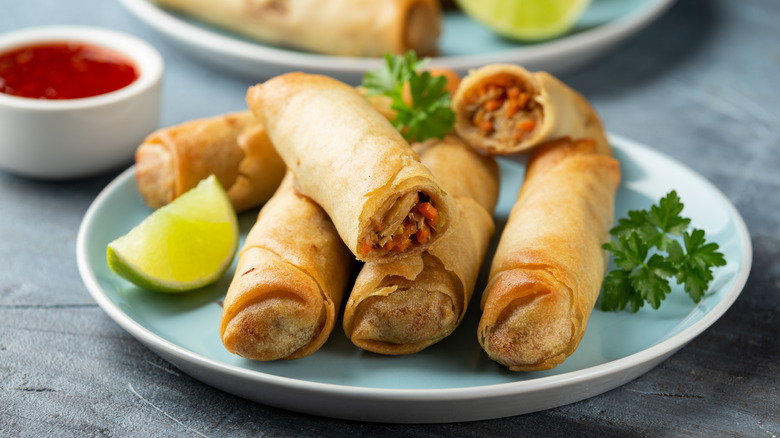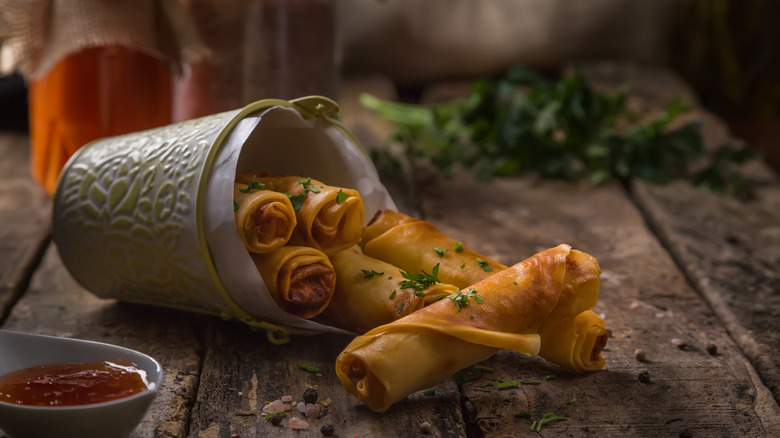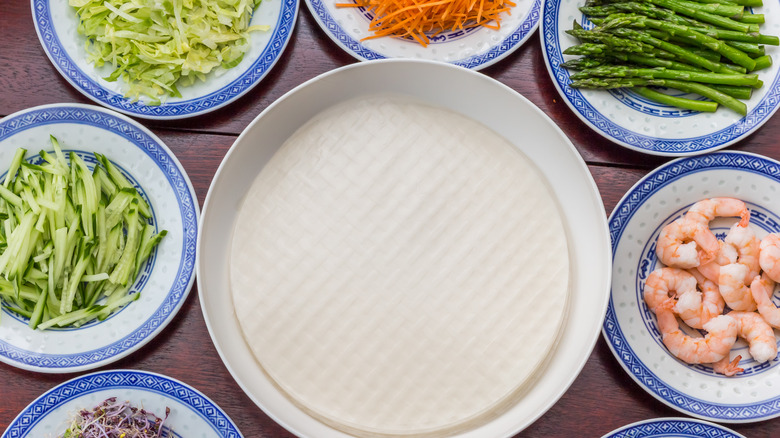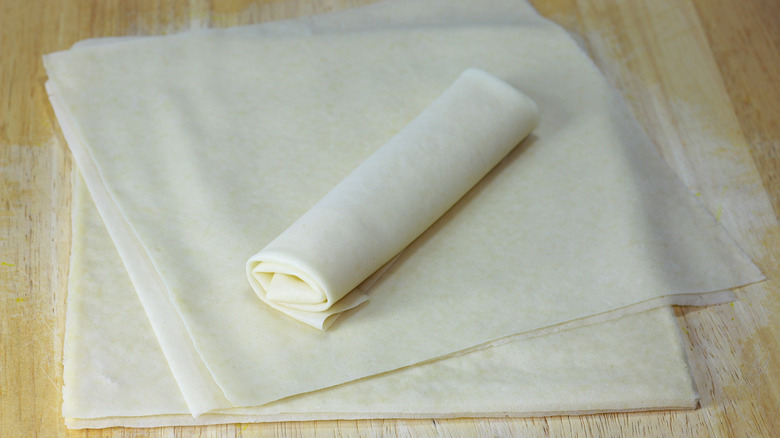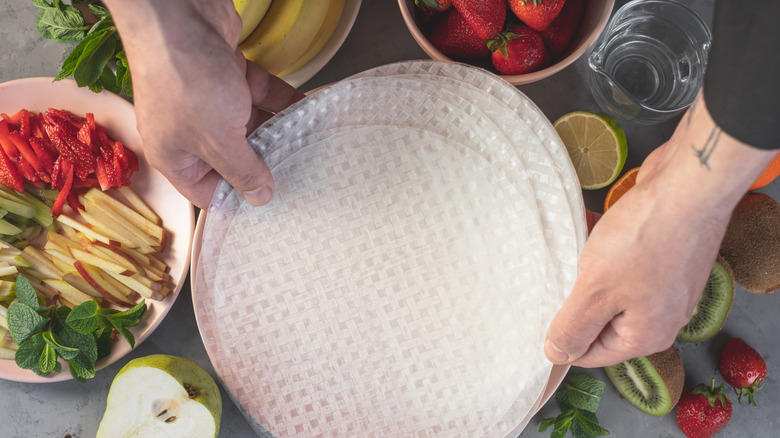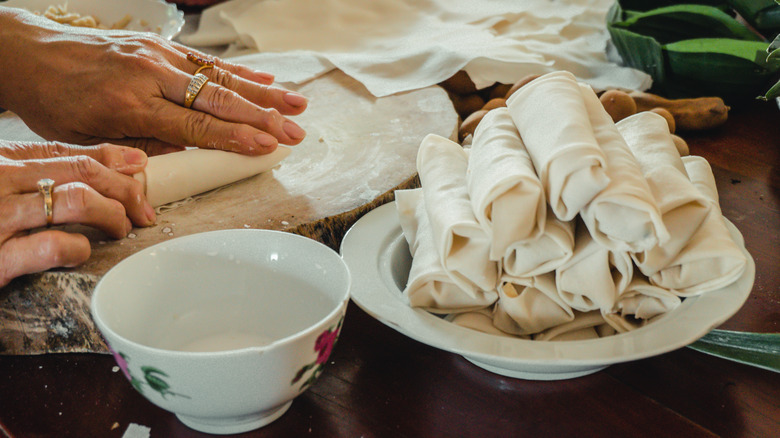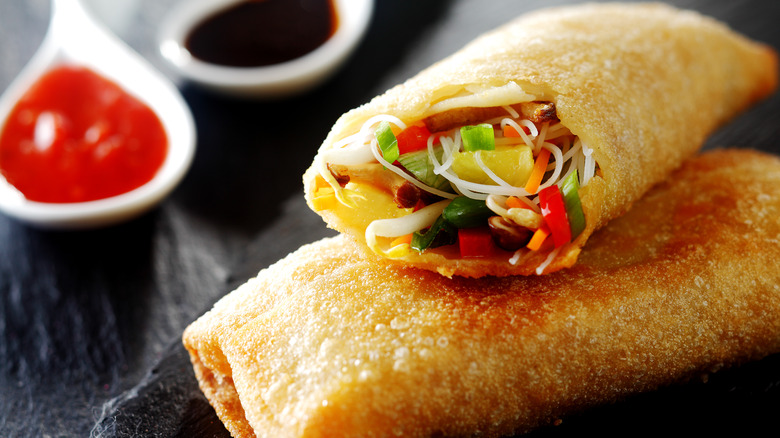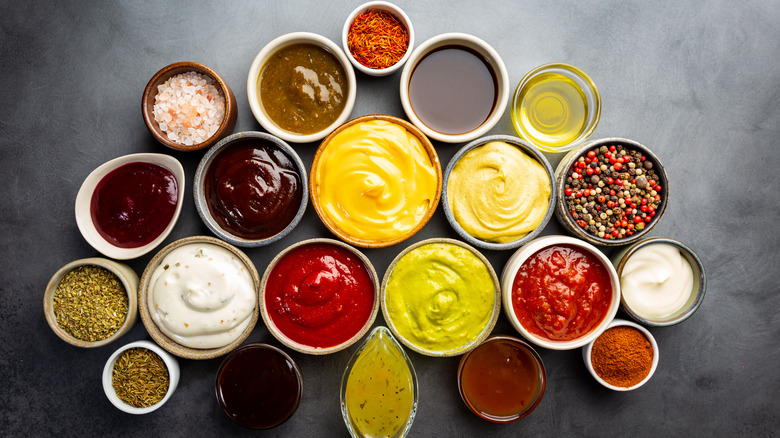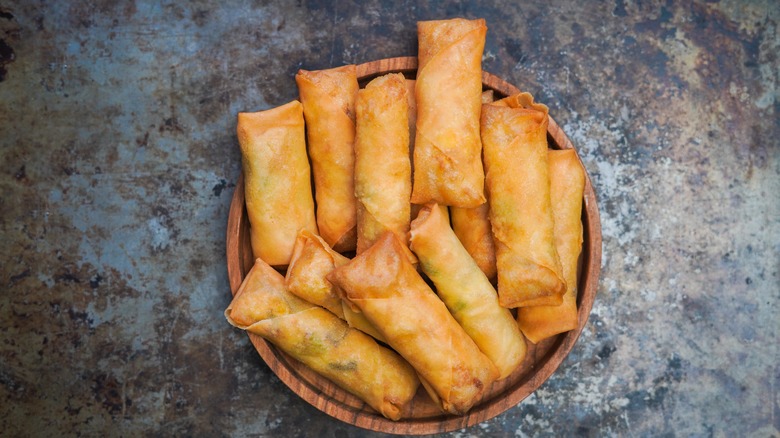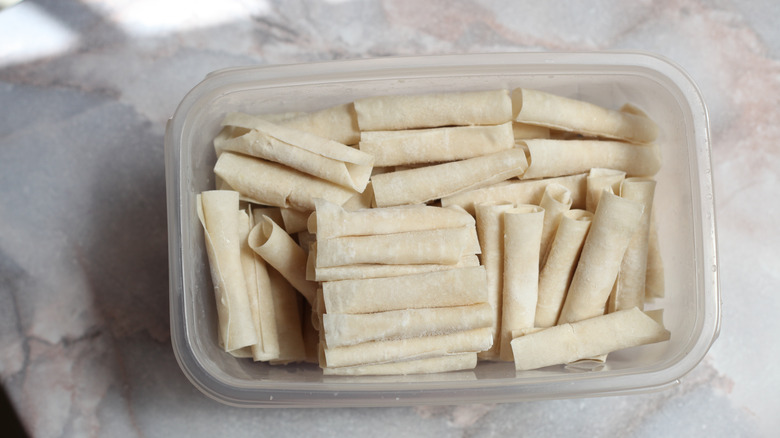Mistakes Everyone Makes When Making Spring Rolls
Whether they are served as an appetizer at an Asian restaurant or a finger food during intimate events with family and friends, you know spring rolls are truly iconic. Janusz Domagala's missing spring roll on "The Great British Bake Off" is among the greatest television mysteries of our time. Spring rolls hold a wealth of history originating in China and later spanning across Indonesia, Malaysia, Philippines, Taiwan, Thailand, and Vietnam.
According to Foodicles, they originated from the Jin Dynasty between 266 and 420 AD. During this time, they were made in the form of a thin pancake that was gifted to family members as a ceremonial dish on the first day of spring. By the Tang Dynasty of 618 to 907, the thin pancakes contained more lavish fillings, which continued into the Song Dynasty between 960 and 1279. It was during the Ming (1368 – 1644) and Qing (1644 – 1912) Dynasties that the spring pancake was first served in a roll form and officially named. That's when the dish evolved into the spring rolls we now know and love. Today, spring roll iterations are as varied as the countries across which they span, and the same can be said for the many American kitchens in which they are made. Read on to find out what mistakes you should avoid the next time you make a batch, and what you can do to correct them.
Mixing up spring rolls with egg rolls
With an extensive history across Asia, it's no wonder that spring rolls have now become a popular food across the globe. In the US, however, the spring roll transformed into a unique, localized version: the egg roll. Many people may use the two terms interchangeably, however, spring and egg rolls are two distinct dishes.
In keeping with the theme of flavors and fillings based on region, egg rolls are an American Chinese snack that has a thick wrapping and usually includes lots of cabbage in the filling. According to The Washington Post, one of the theories about how exactly the egg roll came to be purports that when Southern Chinese chefs could struggled to make the original thin pancake made in Nothern Chinese restaurants, they added egg to the batter. This not only changed the texture but also meant that the thicker wrapper could hold more fillings. As such, unlike spring rolls which are usually filled with light, fresh vegetables, egg rolls often include meat and other non-tradition fillings like avocado. They may even be accompanied by non-traditional dipping sauces like duck sauce or sweet and sour mustard sauce (via Van's Kitchen).
Not preparing your tools and ingredients well in advance
Nothing sets you up for culinary success quite like dotting the i's and crossing the t's of your tools and ingredients. According to the Auguste Escoffier School of Culinary Arts, this process is called mise en place and it lies at the root of every successful chef and kitchen. Even if you have no interest in becoming the next world-renowned Michelin star chef, it's a simple — but highly effective — practice that will make your own kitchen a joy to be in.
The first step is to check your recipe — make sure that you have all the tools you need and that you convert measurement metrics wherever necessary. Second, prepare all the tools you need for your prep work, the folding process, cooking, and serving. Next, gather all your ingredients, and carefully measure them out. Finally, complete all the prep work as detailed in your recipe. In professional kitchens, mise en place is especially crucial for saving time. However, even without any time constraints in your kitchen, this practice is an exceptional way of avoiding frustrating mistakes like doing the same thing twice, or worse, not realizing that you've forgotten an ingredient when it's too late.
Not knowing the different types of wrappers
Now that you've got the concept of mise en place in check, you want to know the different types of wrappers that you can use for your spring rolls. Per St. Louis Magazine, there are several types of wrappers, and since spring rolls are perfect for experimenting and personalizing, knowing which ones to go for depends on the textures you prefer. Spring roll wrappers are used to create the classic fried spring rolls most people think of; they are made using wheat flour and can be used for both sweet and savory spring rolls — yes, dessert spring rolls are a thing.
Rice paper wrappers are another popular option. They are made using rice flour and because they require no cooking, are generally used to make summer rolls or fresh spring rolls. Lumpia wrappers are made using wheat flour and are similar to standard spring roll wrappers. However, they have a more delicate texture, and unlike spring roll wrappers, can either be used as-is or fried. If you're looking for a thicker texture, egg roll wrappers are your go-to, but bear in mind that they may not be as crispy as the spring roll wrappers. You could try each of these and figure out which you like best, or which wrappers work better for different fillings.
Using warm water to soften rice paper wrappers
If you've ever worked with rice wrappers, you'll know that their delicate texture and flavor comes at a price: There is a very thin line between softened and destroyed wrappers. Many recipes on the internet recommend using warm water to soften these wrappers, but that might not be the best technique. Cook's Illustrated tested this using hot, warm, and cold water. It turns out that cold water may be the superior method. This is because warmer water speeds up the softening process, thus making the margin for error much smaller.
On the other hand, cold water softens the wrapper at a slower rate, which gives you a little more control, and more importantly, a bit of a wider margin for error. Additionally, with a recommended soaking time of just 2 seconds in cold water, you have leeway to fill your spring rolls at a leisurely pace, as the wrapper will continue to soften as you go along. All you have to do is pour enough cold water in a baking tray, dip the wrapper, gently remove and hold while excess water drains, place on your rolling surface, and repeat (via eHow).
Not filling and folding them correctly
With your wrappers and fillings ready, here comes the fun part. Per Tasting Table, when using wheat spring roll wrappers, it's important to prevent them from drying out so they remain soft throughout the process. To do this, keep your stack of wrappers covered with a wet kitchen cloth. In addition, it's crucial not to overfill your spring rolls as this increases the chance that they could burst; you should aim for cigar- rather than can-sized spring rolls.
Finally, you want to make sure that the spring rolls are not so tight that the wrap breaks but tight enough that the filling is adequately held and has no air pockets. The diamond technique is one way of doing this. Place a wrapper in a diamond shape in front of you, then fill the bottom third. Next, gently lift the bottom corner of the diamond and roll over the filling — feel for and smooth out any air pockets as you go. When you reach the side corners of the diamond, fold them over one another like you would an envelope and continue rolling. Hold, brush the top corner with egg wash, and then continue rolling until you have sealed the spring roll.
Not experimenting with your fillings
While you may be accustomed to certain spring roll fillings, there is no hard and fast rule about which fillings to incorporate into your own creations. You may even be more inclined to emulate some of your favorite fillings. However, given spring rolls' versatility, how about experimenting with your fillings the next time you make a batch? According to Wonderful DIY, there are a plethora of unconventional but equally delicious spring roll flavors you can try: carrot, apple, and cheese spring rolls, ground beef and bean sprout spring rolls, cheeseburger spring rolls, spicy crab-coconut spring rolls ... the possibilities are endless.
As it turns out, not only can you try unconventional spring roll fillings, but dessert spring rolls are also quite the thing! In the Philippines, turon is a popular dessert snack made with bananas, sugar, and lumpia wrappers (via Tasting Table). Bananas are sliced and sugared, rolled in a wrapper, and then deep-fried as you would savory spring rolls. But this is only one way of enjoying spring rolls as a snack. The next time you're craving something sweet, you can roll up your favorite treats in some spring roll wrappers and see what happens. Who knows, you might just end up with your new favorite dessert.
Not experimenting with your dipping sauce
Once you've mastered experimenting with fillings, or, if you're not quite ready to dive in but still want to experiment with lower stakes, you can play around with the dipping sauce. According to Delighted Cooking, fish and peanut butter sauces are commonly used condiments for spring rolls, often with added sugars, vinegars, chili oils, and soy sauce. Per Drive Me Hungry, the nuttiness of peanut butter dipping sauce is a wonderful pairing for fresh spring rolls as it adds contrasts, while fish sauce — which is usually paired with Vietnamese spring rolls — is versatile and can also be used in vermicelli bowls.
However, there are other sauces you can explore when making spring rolls. Which ones you choose largely depends on whether the flavors of the fillings are sweet or savory. For instance, plum sauce and sweet and sour sauce can be enjoyed with savory spring rolls, while you might try dulce de leche or chocolate sauce with a dessert spring roll. Ultimately, it all comes down to your preference. And as with homemade salad dressings, dipping sauces are an easy way to play around with various flavors and pairings, and when you find something that sticks, it will likely be a pleasant surprise for your palate.
Not keeping them crispy after they are cooked
When you know the sheer pleasure of a crispy fried spring roll, you also know just how underwhelming a limp or soggy spring roll can be. But fear not — even though this is a fairly easy mistake to make, according to Baking Kneads, there are things you can do to ensure that you avoid it as much as possible. It's important to first note that the biggest cause of soggy and limp spring rolls is actually the vegetables contained in the filling. This is because vegetables retain moisture, which in turn makes the spring roll soggy from the inside. Make sure you thoroughly dry the vegetables after washing them so that no more moisture is added to your spring rolls than is absolutely necessary.
Additionally, if you make your own wrappers, it's crucial to make them as thin as possible as they too can retain moisture. Finally — and this is the part you have the most control over — is to ensure that you fry the spring rolls properly. How? By first making sure that the oil is hot enough to lessen the rate of its absorption into the spring rolls — deep frying rather than shallow frying is good for this. You can also freeze the spring rolls before frying, or if you don't have the time, double-fry them to make them extra crispy.
Not storing them correctly
When all is said and done, you want to enjoy those leftover spring rolls — if there are any. The best way to do this is to make sure that you store them well. Per Freeze It, cooked spring rolls can be stored in the freezer for up to 3 months, provided the ingredients in the filling also freeze well. To do this, first make sure that they have cooled completely, place them on a lined baking sheet so none are touching, and leave them in the freezer until they are frozen solid. Once frozen, you can bag them up and return them to the freezer.
When you're ready to enjoy your spring rolls again, the best way to reheat them is on the stove, per Cook Gem. If they were deep-fried, place a non-stick pan on low heat, and once it's heated, place the spring rolls in the pan to heat for 3 minutes on either side. This is assuming they were in the refrigerator. For frozen spring rolls, reheat them in a hot oven for approximately 20 minutes. You may be tempted to use oil for both methods, however, try to avoid this as excess oil may make them soggy.
